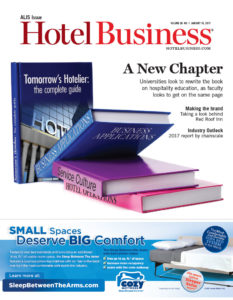The upscale hotel segment is poised for another year of robust earnings and demand growth in 2017, according to industry insiders, even though occupancies are expected to taper off slightly in the face of bustling new supply. As the numbers attest, the ever-growing array of select-service, upscale brands continues to favored among travelers, developers and lenders alike.
By and large, the key performance metrics for the upscale segment are expected to mirror the broader hotel industry in 2017 (minor occupancy losses, modest ADR gains), save for projected growth rates in both supply and demand: According to CBRE Hotels’ Americas Research, upscale rooms supply will grow 6.3% in 2017, outpacing sizeable demand growth of 5.7%. Those levels are notably higher than CBRE Hotels’ Americas Research industry-wide 2017 forecast of 1.8% supply growth and a 1.5% increase in demand.
“The trend that was established a few years ago in the upscale category is it’s still dominating the supply story and has the fastest-growing demand,” said Jack Corgel, senior advisor to CBRE Hotels’ Americas Research. “The majority of the property pipeline is in just the upscale and upper-midscale segments. It really hasn’t changed from two to three years ago.”
Yet even with anywhere from two to five times more new supply than other segments, sources said upscale hotels will post another robust year in 2017. CBRE Hotels’ Americas Research is expecting a minor occupancy dip of -0.6% to 73.4% overall, an ADR gain of 2.9% to $142.71 and RevPAR growth of 2.2%, to $104.76. STR, meanwhile, is projecting a somewhat more conservative forecast for the segment, with a year-end 2017 occupancy decline of -1.3%, ADR growth of 2.5% and a RevPAR increase of 1.2%.
“If you look at the absolute occupancy rates, they’re down a little bit, but those absolute occupancies are still pretty high,” said Bobby Bowers, SVP of operations for STR. “The only place you can grow occupancy, especially at the top end, is on the days when nobody wants to be there, and that’s usually a Sunday night.”
That puts many upscale hoteliers in the happy predicament of primarily needing to focus on driving rate this year, while boosting RevPAR through shrewd revenue management. Sources told Hotel Business that reinvesting in existing properties, while strengthening brand awareness, will also be keys to success in the currently cramped upscale marketplace.
“Speaking specifically to the year ahead, I expect we will continue to benefit in ADR growth as we reposition all of our recently renovated hotels, and all hotels will continue to realize occupancy gains as we introduce a growing customer base to the Sonesta brand,” said Carlos Flores, president and CEO of Sonesta International Hotels. “The Sonesta projections are strong, well above industry forecasts. With 95% of our U.S. hotels recently renovated and record guest-experience scores, we plan to continue to see steep increases in our primary financial measures.”
For other owners, the focus this year remains on ground-up development, since upscale hotel projects are still the easiest sell to lenders, especially at this late stage in the current lodging cycle. Sources told Hotel Business that the popularity of the upscale brands, their lower operational overhead compared to full-service assets, and their resulting healthy profit margins are just a few of the reasons why lenders still perceive far less risk in upscale ventures, compared to other segments.
“Upscale is really where a lot of the investors are feeling comfortable,” said Shawn Gracey, EVP of hospitality for Key International. “Banks are comfortable placing debt on assets that are proven, especially if you’re of the mindset that we’re in the seventh inning of the cycle. It’s easier to benchmark. They look at the Courtyards and the Hilton product, and they’re able to put metrics based on performance.”
There also remains a wide range of locations, site types and conversion opportunities suitable for upscale brands, which helps to disperse the substantial incoming new supply and stimulates demand growth. Sources said that as long as there are viable markets lacking upscale product, deals will continue to be made, at least well into 2017.
“When you’re talking about upscale, select-service hotels, they’re a lot easier to do,” said Bowers. “There’s a lot of opportunity to do them, and the spots where you can put them, there are a lot more of those. You’ve got a lot of properties that were built 20-plus years ago that are beginning to cycle out, and after a certain time, either you knock it down or you convert it to another brand. That deal is just attractive.”

